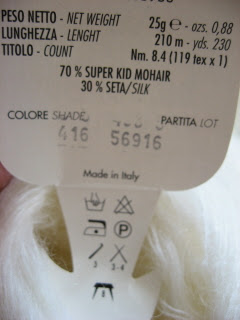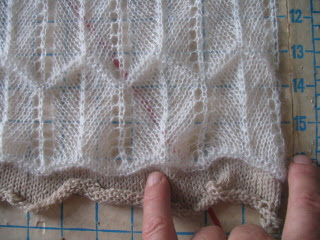
Welcome!
I love the feel and look of Lace Weight Mohair.
I work with this yarn quality on a daily basis at my local yarn shop, as it is a popular quality of hand knitting yarn for garments and accessories.

 |
| Blocked & Unblocked Hand Transferred Lace Using Lace Weight Mohair. |
Lace Weight Mohair is surprisingly strong, being spun with either a Nylon or Silk core.
The colour range for Lace Weight Mohair is exceptional and it knits up so light and airy while being incredibly soft. This light weight contributes to the incredible yardage in each 25g ball. On average 225 yards! So a little goes a long way.
This is not the harsh and scratchy Mohair of days gone by. Educate yourself as a consumer and go visit your local yarn shop if you have not visited one in a while. There have been and continue to be, great developments in the variety of yarns produced by major yarn mills around the world.
(Of course some people will never be able to wear or work with this long hair fibre due to the "fluff" factor which get's in their nasal passages or if they are hyper allergic to goat hair.)

One winter day back in January I was organizing the Mohair Yarn section at the yarn store and my thoughts turned to my niece Meghann who had recently given birth to a daughter. The idea came to me that I would knit her a Christening Gown as a present.
I had a little girls Empire Waist Coat pattern already charted at home and I started imagining how this would look modified with a longer and fuller "skirt" section to make it look like a traditional baptismal garment worn by babies.

In my mind, the colour would be white with pearl buttons and silk ribbon for accents and an intricate Lace Stitch technique. I imagined a lace stitch pattern that would provide visual interest and cause the hemline to scallop or form points. No simple eyelets and definitely not Feather & Fan! Too pedestrian.
Maybe a Silk fabric for the bodice of the coat. The yarn would be Silk to match. Silk and - Mohair! Bingo! A perfect choice for what I had in mind and I was standing right in front of it.
I had been wanting to knit something with this quality of mohair yarn on my Superba for ages but I hadn't known what...until now. With my yarn choice made I purchased a ball of Madil "Kid Seta", a beautiful blend of Kid Mohair and Silk and went home that night to review my knitting library for an appropriate Lace Stitch Pattern and begin swatching.
Lace Stitch Patterns.

As a knitting teacher I do my fair share of lace knitting at work but rarely do I knit complete garments in this technique.
There are thousands of stitch patterns and techniques to choose from and only so many hours in the day, so one has to think carefully about what you will commit yourself to in terms of projects.
At the time I began knitting the Christening Gown on my Superba, I started this hand knit lace project from the Holiday 2006 issue of Vogue Knitting.
I love Vogue Knitting. They always have great garment designs combined with gorgeous stitch techniques.
The garment is the Tie Front Cardigan by knitwear designer and artist Shirley Paden, who is an extremely talented and technically brilliant knitter and pattern writer.

I had been drooling over this Tie Front Cardigan pattern for months and finally succumbed to the temptation.
The Stitch pattern is called "Frosted Flowers" which comes from a Japanese hand knitting stitch pattern book and features a nice balance of paired decreases and eyelets.
 |
| Frost Flowers Lace Stitch |
This is an example of what I like in lace stitches. The knitting shown has not been blocked yet so the yarn overs or "eyelets" are not full open but you get the idea.
Notice with the Frosted Flowers stitch pattern that there are rows of purl stitches that run like ridges horizontally through the fabric. I love that in lace. I love how the paired decreases are clustered together and the eyelets are grouped together. I am not the biggest fan of all-over lace stitch patterns with lots of eyelets. My preference is for a stitch pattern that produces a more substantial fabric.
So I went in search of one suitable for working on my Superba Knitting machine, with similar elements.
Japanese Stitch Patterns

Ribbon Knits is a Japanese Hand Knitting publication from the early 1980's, that I purchased on ebay a few years ago. I remembered that Ribbon Knits had many interesting lace stitches that might translate well on my Superba.
As far as the style of lace stitch pattern I was interested in, I knew that I wanted the structure of the stitch pattern to stand out.
I wanted a stitch pattern with strong vertical and horizontal lines and lots of stitch transfers to make the fabric undulate.
In Lace Knitting, if you line up your paired decreases and Yarn Overs row after row, the horizontal edges of the fabric automatically create scallops or chevrons, also referred to in english as a "Saw Tooth" edge.

I did NOT want a soft, all-over design to the stitch pattern. No clusters of simple eyelets.
Knitting with this fine Mohair yarn, there would be enough drape happening as it was. Also, as I had chosen White to knit with I did not want to go to all the effort of transferring the stitches, only to have the pattern disappear against a white background. My memory served me well as I rediscovered this Chevron Lace Stitch used in Ribbon Knits.

Japanese knitting publications are a personal favourite of mine. Japanese knitting publications have the best layout and technical information for both hand and machine knitters, with beautiful stitch patterns and the best finishing techniques.
Translation: From Hand Knitting Instructions to the Machine

Knowledge of the Japanese language is not necessary to understand and use these stitch patterns as these publications use standardized knitting stitch symbols. They also provide excellent diagrams of how to perform the required techniques on a knitting machine.

Now don't be dismayed by looking at the Stitch Chart for the Chevron Lace pattern, which is below. I take you through the "How To" step by step in a series of seperate posts, beginning with How To Knit A Lace Weight Mohair Gauge Swatch: Part 1.
What I want you to do is to look at the structure of the stitch pattern as it is printed and see if you can identify what it was that first appealed to me about this particular stitch? Do you see it?

All the stitch symbols line up! They are continuously repeated, row after row vertically.
Furthermore, the same pattern is repeated vertically as well as horizontally. To me this means that this will be easy to memorize and very easy to execute on my knitting machine, as I will be transferring the same group of stitches over and over.

This Chevron Stitch Pattern has a repeat of 14 + 3 stitches x 18 rows. The Gauge Swatch below shows how this translates into Lace Weight Mohair, which I knit on my Superba.

Why Transfer By Hand?
I am well aware that there are automatic lace transfer carriages produced by Japanese manufacturers including Silver Reed (brand names Singer, Studio, Knitmaster) and Brother (Jones, KnitKing). I have one. It won't work without crying tears of frustration every other row using Lace Weight Mohair, as the 4.5mm gauge or needle space is too fine for this kind of yarn.
The hairs of the mohair yarn will catch on the sinker posts (even with waxing) and the transfers will not happen consistently.
Also, these transfer carriages are only available on the fine and ultra fine gauge machines. What does one do on a chunky or bulky knitting machine?
More importantly: what if you want to introduce rows of contrasting purl stitches, cables or rib stitches to the lace fabric?
You cannot do this style of Lace using an automatic Lace Transfer Carriage.
 |
| ©Superba Knitting™ |
To achieve the style of lace stitch that I prefer, one would have to do multiple passes of an automatic lace carriage before knitting any actual rows anyway, so transferring by hand is just as fast to me.
As I said, I hand knit. Everyday. Transferring stitches on a machine by hand is easy. Straightforward. Not time consuming at all.
The advantage of doing this on a SUPERBA is the machine's ability to handle such a wide variety of yarn styles and fibers with ease.

You will find your Superba has the ability to handle a tricky fibre like Mohair with such finesse, due in part to a slightly larger needle gauge and the shape of the flow combs.

The ease of using the Transfer Carriage accessory to move large numbers of stitches back and forth between needle beds to create rows of contrasting purl stitches allows a SUPERBA to produce gorgeous stitch patterns that are usually only done by hand knitting.

The carriages on these machines are so light and easy to move back and forth that all this movement does not turn into a strenuous workout.

We can quickly lower and raise the Front Bed to check on our work and repair any stitches that do happen to drop off the needles.

The end result of all this work is a gorgeous, gossamer fabric with a delightful soft feel and wonderful stitch definition.


So don't be intimidated by yarns and techniques that you may think would not be possible to do on a standard gauge machine.
Your Superba Double Bed Knitting Machine will surprise you!
I encourage you to visit and support your local yarn shop and to purchase a ball of either Madil Kid Set, Rowan Kid Silk Haze, Alchemy Haiku or Prism Gossamer lace weight mohair yarn and sample some lace stitches!
Take good care.
Patrick.





